
Figure 7.2.1. (Left) Water skier waiting for the boat to accelerate him to top speed. (Right) Skiing at top speed.
| < Previous Section | Home | Next Section > |
Suppose h is a function with a rate of change function $r_h$. The function $r_h$ is a function, so we can inquire about its rate of change function, $r_{(r_h)}$.
Suppose $r_h$ has a rate of change $r_{r_h}(k)$ at the moment $x=k$. Then $r_{(r_h)}(k)$ can give us, in principle, the same kind of information about the behavior of $r_h(x)$ around $x=k$ as $r_h(k)$ gives us about the behavior $h(x)$ around $x=k$.
When $r_{(r_h)}(x)$ is positive at $x=k$, $r_h$ is increasing over an interval containing the value of k; when $r_{(r_h)}(x)$ is negative at $x=k$, $r_h$ is decreasing over an interval containing the value of k. When $r_{(r_h)}(x)=0$, or $r_{(r_h)}(x)$ is undefined at $x=k$, then $r_h$ has all the possibilities we investigated for $r_h$ in relation to h.
In line with the different notations for rate of change functions introduced in Chapter 6,we can represent higher order rate of change functions in three ways. Each notation has strengths and weaknesses.
Let k be a function defined as $k(x)=2\sin(x)e^x$. Then we can represent $r_f$ and its rate of change function in three ways:
| Rate Notation |
Differential
Notation |
Prime
Notation |
| $$r_k(x)=2e^x\left(\sin(x)+\cos(x)\right)$$ $$r_{\left(r_k\right)}(x)=4e^x\cos(x)$$ | $$\frac{d}{dx}\left(2\sin(x)e^x\right)=2e^x\left(\sin(x)+\cos(x)\right)$$ $$\frac{d^2}{dx^2}\left(2\sin(x)e^x\right)=4e^x\cos(x)$$ | $$k'(x)=2e^x\left(\sin(x)+\cos(x)\right)$$ $$k''(x)=4e^x\cos(x)$$ |
As noted in Chapter 6, the three notations suggest different ways of thinking about rate of change functions.
Reflection 7.2.1. Confirm for yourself that $\dfrac{d}{dx}\left(2\sin(x)e^x\right)=2e^x\left(\sin(x)+\cos(x)\right)$ and $\dfrac{d^2}{dx^2}\left(2\sin(x)e^x\right)=4e^x\cos(x)$
It is for that reason we will use a superscript to represent higher order rate of change functions, where $r_k^{(n)}(x)$ represents the $n^{th}$-order rate of change function for the function $k$ where $k(x)=2\sin(x)e^x$.
All higher order rate of change functions are also first-order rate of change functions of a rate function. Specifically, $$r_f^{(n)}(x)=r_{\left(r_f^{(n-1)}\right)}(x)$$which says $f'$s nth-order rate of change function is the first-order rate of change function of $f's$ $(n-1)$th-order rate of change function.
$$\color{red}{\text{(Eq. 7.2.1)}}\qquad \frac{d^n}{dx^n}2\sin(x)e^x=\frac{d}{dx}\left(\frac{d^{n-1}}{dx^{n-1}}\left(2\sin(x)e^x\right)\right)$$
tells us to derive the rate of change function for the nth-order rate of change function of $2\sin(x)e^x$ we differentiate the $(n-1)$th-order derivative of $2\sin(x)e^x$.
A disadvantage of differential notation is that, when applied to a function's defining formula, it is easy to think you are only acting symbolically on a formula, forgetting you are finding the exact rate of change function for a function that has this formula as its rule of assignment.
It is for this reason we often mix notations, such as $$\begin{align}\text{Given: }k(x)&=2\sin(x)e^x\\[1ex]r_k^{(n)}(x)&=\frac{d^n}{dx^n}2\sin(x)e^x\end{align}$$
We can express Equation 7.2.1 using prime notation as $$f^{(n)}(x)=\left(f^{(n-1)}\right)^{'}(x)$$which means the nth-order rate of change function for the function $k$ is the rate of change function for the $(n-1)$th-order rate of change function for the function $k$.
| Function | $n$ | $n^{th}$-order rate of change function |
| $f(x)=x^5-x^2-\cos(x)$ | 2 | |
| $g(t)=\sin(t)e^{2t}$ | 3 | |
| $j(p)=\ln(p)$ | 2 | |
| $k(y)=y^{10}$ | 6 |
Second- and third-order rate of change functions have direct applications in the sciences, in economics, and in characterizing behaviors of functions in general. In Chapter 10, we will use higher order rate of change functions to develop methods to approximate values of functions we cannot compute directly.
Acceleration, as a quantity, is often associated most closely with mechanics. If an object is "speeding up", a natural question is, "At what rate is it speeding up?". For example, suppose an object at rest "speeds up" at a constant rate to a velocity of 15 m/sec over a period of 5 seconds. At what rate did it speed up? It increased its velocity at the rate of 3 m/sec every second, or 3 (m/sec)/sec.
Acceleration at a moment is the rate at which a rate of change function varies at that moment.
Mechanical force is defined in terms of an accelerated mass, or $F=ma$, where m is a measure of mass, typically in kg, and a is the object's acceleration, typically in (m/sec)/sec. A Newton is the force required to accelerate a mass of 1 kg at a rate of 1 (m/sec)/sec.
We could represent forces using the language of rate of change functions. If $s(t)$ represents a number of meters traveled in t seconds, then instead of $F=ma$ we could write
They all say the same thing -- force is the product of a mass and the rate at which its velocity varies.
We also often speak of economic quantities in terms of acceleration: "How fast is inflation varying at this moment?" Inflation is a rate of change of the cost of goods. To ask how fast it is varying is to ask about how the price of goods is accelerating.
Notice that the concept of accleration can be applied broadly. We could speak of the rate at which an object's acceleration accelerates.
Imagine you are a water skier, waiting in the water for the boat to pull the rope taught and accelerate to top speed (see Figure 7.2.1). Your arms will hurt if the boat accelerates too rapidly. That "hurt" is due to the boat trying to accelerate your body to top speed in a short period of time.
The rate at which you accelerate is called jerk. Let $s(t)$ represent how far the boat pulls you from a stationary position in t seconds. The jerk you experience t seconds after the rope becomes taught is represented in differential notation by $\dfrac{d}{dt}\left(\dfrac{d^2}{dt^2}s(t)\right)=\dfrac{d^3}{dt^3}s(t)$, or in rate notation by $r_{\left( r_s^{(2)}\right)}(t)=r_s^{(3)}(t)$.

Drag racing drivers experience jerk similarly to water skiers. The dragster in Figure 7.2.2 accelerated from 0 mi/hr to 329.21 mi/hr in 3.728 seconds, for an average acceleration of 88.31 (mi/hr)/sec. If its acceleration was constant, the jerk would be 0 (no change in acceleration during the race).
However, acceleration at the beginning of the race is far greater than at the end. A dragster can reach 100 mi/hr (161 km/hr) from start in 0.8 sec, but can take 2.2 sec from start to reach 200 mi/hr (322 km/hr).
The dragster's average acceleration in the first 0.8 sec is $\dfrac{100}{0.8}\text{ (mi/hr)/sec }$in its first 0.8 seconds while its average acceleration is $\dfrac{100}{1.4}\text{ (mi/hr)/sec }$in its next 1.4 seconds.
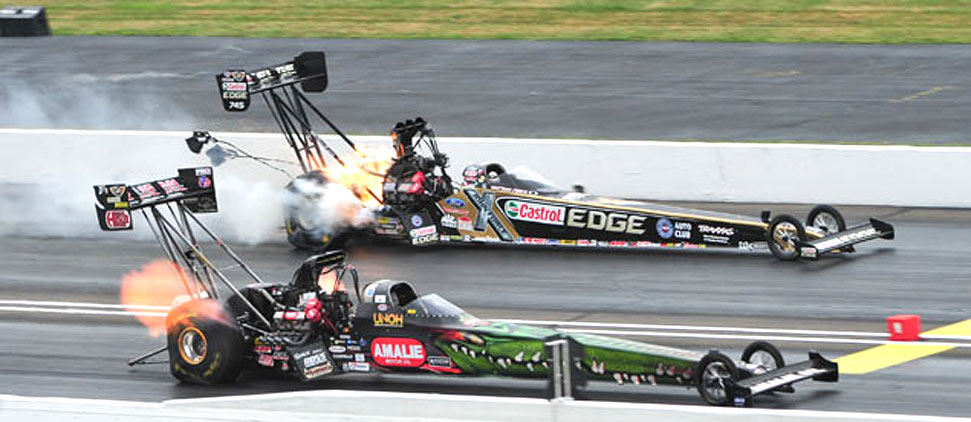
Figure 7.2.2. A dragster at the end of its race. The record for 1/4 mile (0.40 km) is 3.58 seconds with a top speed of 386 mi/hr (621.2 km/hr).
Suppose f is a function of x and it has a rate of change at every moment in an interval I. In Section 7.1 you learned you can tell whether the function is increasing or decreasing at the moment $x=k$ in I by examining the sign of its rate of change function $r_f(x)$ at $x=k$:
Unfortunately, when $r_f(x)$ is not zero, we have no information about the way f is increasing or decreasing. Figure 7.2.3 illustrates this ambiguity. Both functions f and g are increasing over the interval $x>0$. However, while f increases, the value of $r_f$ also increases, whereas as g increases, the value of $r_g$ decreases.
Figure 7.2.3. Both f and g increase in value as the value of x increases over the interval $x>0$. However, as the value of x increases, the value of $r_f(x)$ increases but the value of $r_g(x)$ decreases.
Reflection 7.2.2. Reset the movie in Figure 7.2.3 to the beginning, then play the movie little by little.
Restate the third bullet in terms of rate of change of $f$ and $g$ with respect to x.
Remember $r_f$ and $r_g$ in Figure 7.2.3 are also functions of x, so we can look at the sign of their (i.e., $r_f$'s and $r_g$'s) rate of change at a moment to see whether they are increasing or decreasing at that moment.
Let's examine the first- and second-order rate of change functions for f as defined in Figure 7.2.3.
\begin{align}\frac{d}{dx}\left(x^2+1\text{ if }x>0\right) &= 2x\text{ if }x>0\\[2ex]
\frac{d^2}{dx^2}\left(x^2+1\text{ if }x>0\right) &= \frac{d}{dx}2x\text{ if }x>0\\[2ex]
&= 2\text{ if }x>0 \end{align}
Since $r_{(r_f)}(x)$ is positive for all values of $x>0$, $r_f$ is increasing for all values of $x>0$. The function f is therefore increasing over the interval $x>0$, and its rate of change is increasing over $x>0$
Now let's do the same for g as defined in Figure 7.2.3.
\begin{align}\frac{d}{dx}\left(\sqrt{x}-3\text{ if }x>0\right) &= \frac{1}{2}x^{-1/2}\text{ if }x>0\\[2ex]
\frac{d^2}{dx^2}\left(\sqrt{x}-3\text{ if }x>0\right) &= \frac{d}{dx}\left(\frac{1}{2}x^{-1/2}\right)\text{ if }x>0\\[2ex]
&= -\frac{1}{4}x^{-3/2}\text{ if }x>0\\ \end{align}
Since $x>0$, $-\dfrac{1}{4}x^{-3/2}$ is negative for all values of x, and therefore $r_g(x)$ is decreasing for all values of $x>0$. The function g is therefore increasing over the interval $x>0$, but its rate of change is decreasing over $x>0$.
There are standard terms for describing functions' behavior that are based on a function's second-order rate of change (the rate of change of its rate of change function).
Play the animation in Figure 7.2.4.
How would you describe the behavior of the red graph that is tangent to the graph of $y=f(x)$ at $x=k$ as k varies (Figure 7.2.4, Left)?
Many people describe the red graph as having a rate of change that gets smaller (less steep), equals zero, and then gets larger. However, if you look at the value of $r_f(k)$ as k varies, you will see it is always getting larger. This is because a sequence of numbers like -10, -9, -8, ..., -1, 0, 1, 2, 3, ... is increasing. Each term is larger than the one preceding it.
Reflection 7.2.3. Describe the behavior of the graph in the right side of Figure 7.2.4. How does its rate of change vary as the value of k varies.
Reflection 7.2.4. Determine $\dfrac{d^2}{dx^2}$ of both f and g as given in Figure 7.2.4. What do their values tell you about $r_f$ and $r_g$? About f and g?
Suppose f is a function, and $r^{(2)}_f(k)$=0. If $r^{(2)}_f(x)$ is continuous and changes sign around $x=k$, then f is said to have a point of inflection at $x=k$.
Another way to put this is f has a point of inflection at $x=k$ if $r_f(x)$, the rate of change of $f$ with respect to x, changes from increasing to decreasing or from decreasing to increasing around $x=k$.
A consequence of $r_f(x)$ changing from increasing to decreasing or decreasing to increasing is $f''(k)=0$ and $f''(x)$ changes sign around $x=k$.
The function q defined as $q(x)=(x-2)^3+2$ has a point of inflection at $x=2$: $$\begin{align}q'(x)&=3(x-2)^2\text{, so }q'(2)=0\\[1ex]q''(x)&=6(x-2)\text{, so }q''(2)=0\\[1ex]\text{Finally, } q''(x)&\text{ changes sign from negative to positive around $x=2$}\end{align}$$Therefore $q'(x)$ changes from decreasing to increasing, making a point of inflection at $x=2$. The graph in Figure 7.2.5 illustrates this.
Figure 7.2.5. Function f has a
point of inflection at x=2.
$f'(2)=0$, $f''(2)=0$, and $f''(x)$ changes from negative to
positive around $x=2$.
Reflection 7.2.5. This is an important reflection!
Stop the animation in Figure 7.2.5 at three different places. Write answers to these questions each time you stop it.
Reflection 7.2.6. Explain the significance of $r_{(r_f)}(x)$ varying from negative to positive as x increases around $x=2$ in Figure 7.2.5.
Higher order rate of change functions are used in defining physical quantities like force, acceleration, and jerk. They are also useful for characterizing the behavior of functions by characterizing the behavior of their rates of change functions. In the case of behaviors of functions in general.
The table given below summaries the information you can glean by looking at values of first- and second-order rate of change functions in combination.
| $f''(k)>0$ |
$f''(k)<0$ |
$f''(k)=0$ |
|
| $f'(k)>0$ |
f(x) increasing around $x=k$ $r_f(x)$ increasing around $x=k$ |
f(x) increasing around $x=k$ $r_f(x)$ decreasing around $x=k$ |
f(x) increasing around $x=k$ Ambiguous regarding what $r_f(x)$ is doing around $x=k$ |
| $f'(k)<0$ |
$f(x)$ decreasing around $x=k$ $r_f(x)$ increasing around $x=k$ |
$f(x)$ decreasing around $x=k$ $r_f(x)$ decreasing around $x=k$ |
$f(x)$ decreasing around $x=k$ Ambiguous regarding what $r_f(x)$ is doing around $x=k$ |
| $f'(k)=0$ |
Local minimum at $x=k$ |
Local maximum at $x=k$ |
Ambiguous. Requires further investigation. Possible that $\left(k,f(k)\right)$ is a point of inflection.
|
$f(x)=(\ln x)\cos(x^2)$
$h(x)=g(f(x))$, where g and f are defined as above.
$k(x)=\log(\cos(x))$
The graph of $y=k(t)$ for a function k is displayed below. Over what intervals, approximately, is $k'$ increasing? Decreasing?
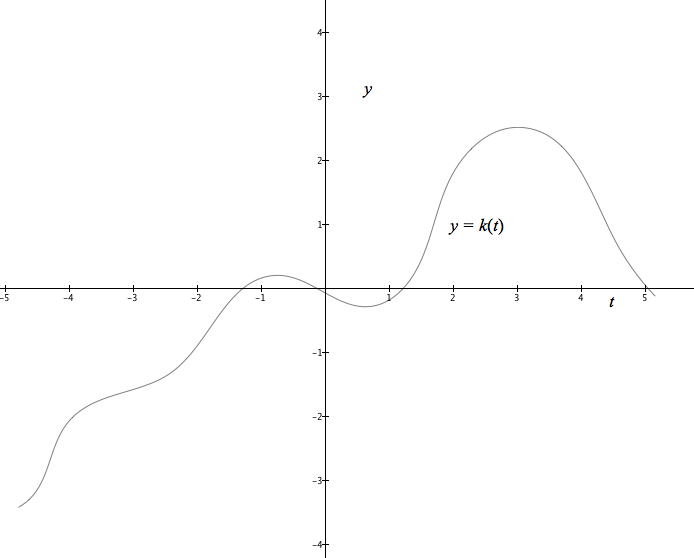
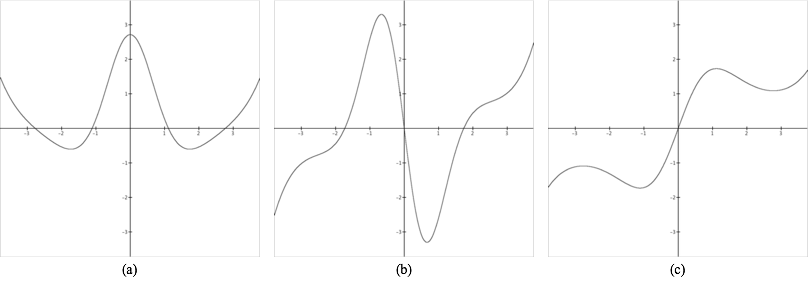
The graph of a function h is displayed below. Complete the tables below, giving approximate values where $h'$ and $h''$ are zero, and giving approximate intervals over which $h'$ and $h''$ are increasing or decreasing.
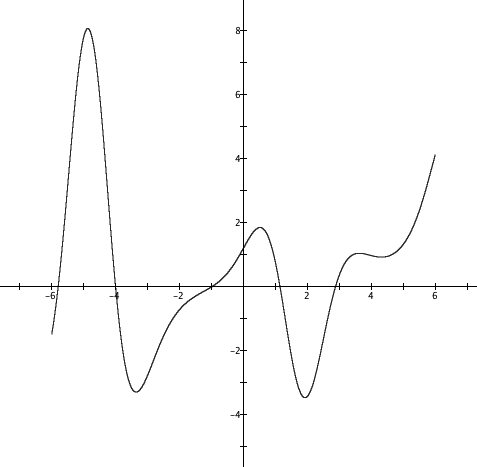
| h' is zero at these values of its independent variable |
h' is increasing over these intervals | h' is decreasing over these intervals |
| h'' is zero at these values of its independent variable |
h'' is increasing over these intervals | h'' is decreasing over these intervals |

Two of these functions have another of the three as an accumulation function. Which ones have another as an accumulation function, and which function is its accumulation function?
Masakazu visited Disneyworld to enjoy a new ride, called the Rocket Sled. In the Rocket Sled, Masakazu was strapped into a car seat, facing forward, with a six-point harness across his chest and shoulders. The car accelerated forward and backward along a long, straight rail. The graph below shows Masakazu's velocity in relation to the number of seconds since the Rocket Sled began moving.
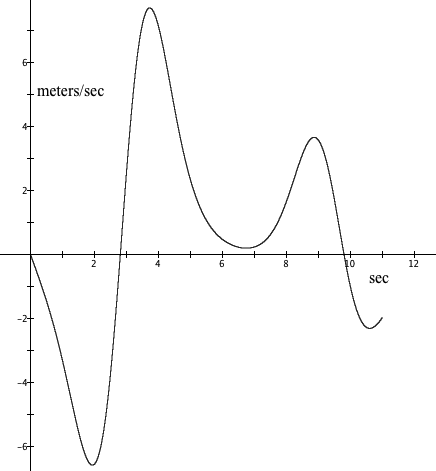
The graph below shows the volume of accumulated oil in a holding tank over a 24-hour period. Answer questions (a)-(d) with approximate values.
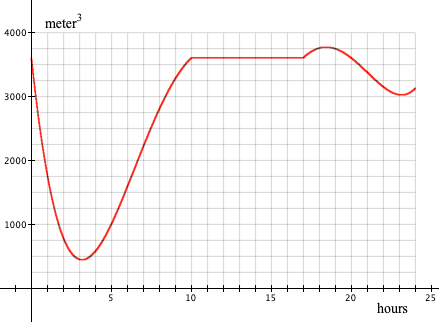
| < Previous Section | Home | Next Section > |